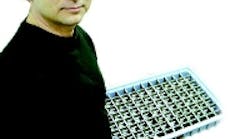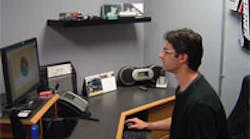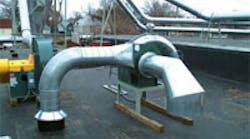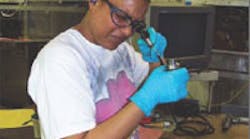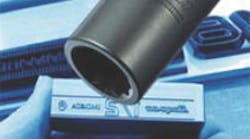Bill Ehnstrom of Vincent Precision Machining shows completed medical-device components done with five Kurt vises.
Kurt vises make for fast changeovers at Vincent Precision Machining.
Vincent Precision Machining (www.vpmachining.com) slashed its setup times for medical components to less than one minute per part from five minutes per part by changing its workholding. In addition, the change allowed the shop to put more parts under the spindle, provided workholding rigidity for repeatable precision, and eliminated costly scrap. The shop switched from two aluminum-body, double-station vises mounted on its Bridgeport 1000 XP3 vertical machining center to five double-station HDL vises made of 80,000 psi ductile iron.
The HDL vises from Kurt Manufacturing Co. (www.kurtworkholding.com) feature changeable iron jaws that Vincent machines to match the outer contours of its medical components. That, in effect, creates custom workholding fixtures using a standard-model vise base. The setup nests parts securely, so there is no chance of misalignment or chatter during high-speed machining. When the job is complete, the shop can replace the vise jaws with others for different jobs.
"We struggled through two different workholding setups that did not have the necessary rigidity and holding power for our difficult-to-machine medical parts," says Bill Ehnstrom for Vincent Precision Machining.
"During heavy milling operations, parts tended to creep upward and out of alignment within vise jaws. Small chips would imbed between the part and vise jaws, causing all kinds of problems. We couldn't operate the Bridgeport machine to its full potential on this particular project, so we looked for a better workholding solution."
The workholding challenge was a 420 stainless steel 1.500-in. by 1.000-in. component for a medical device that had to be machined with a series of recessed flat and contoured surfaces inside a center slot. The shop had to produce these components to tight tolerances with near-perfect finishes to eliminate secondary operations. Quantity requirements averaged 250 parts per week, a stretch for the previously used dual twin-station vise setup. Ehnstrom says the numerous complex features that the parts required made the 420 stainless especially hard and tough to machine. "The Kurt vises, having ductile iron bodies, gave us the needed rigidity. That, plus the machine table and base are also iron castings, so everything from the vise clamping stations down to the floor is solid iron," he says.
Besides providing fast part loading and unloading, the Kurt vises conserve operator motion because less than half a turn of the vises' screws is needed to release parts. They also handle 20 parts at a time, as opposed to the old vises that did eight at a time. This frees Ehnstrom for a full half hour to work on other projects.
The Kurt vises reduce cycle time and maintain quality at Vincent. Measuring 21-in. long and 6-in. wide, the vises are compact and position within 1 in. of each other, so spindles travel less to get from part to part and in and around the vises for complex machining operations. Vise clamping forces of up to 5,556 lb. at 70 ft.-lb. of input torque deliver accuracies to 0.001 in., well within Ehnstrom's tolerance requirements.
Ehnstrom also says he likes the quick-change jaw feature of the Kurt vises because removing their stationary jaws only takes a half turn of a hex key. The jaws then self-align for fast and accurate changeover from job to job.
